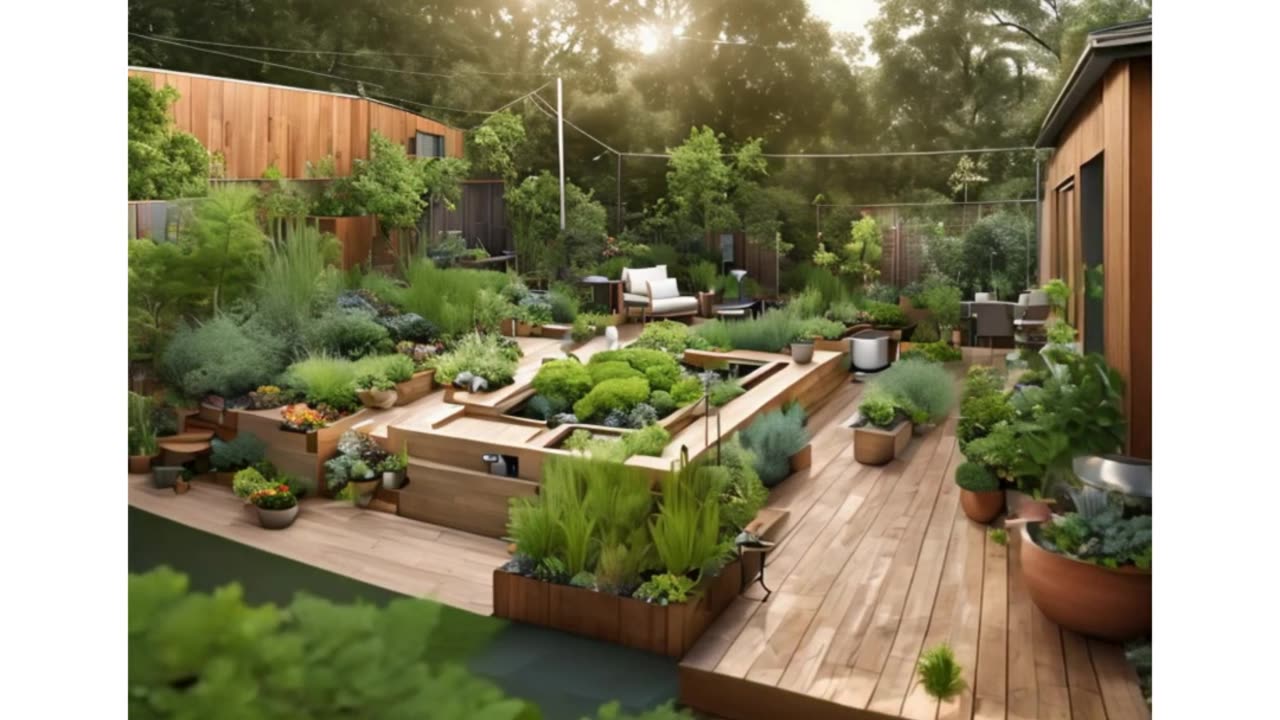Premium Only Content

The Self-Sufficient Backyard: Your Ultimate How-To Guide
In an era where self-reliance and sustainability are more crucial than ever, the self-sufficient backyard emerges as a transformative approach to living. This concept combines the age-old practices of gardening, canning, and permaculture with modern innovations like vertical gardening and straw bale gardening. Embracing such a lifestyle not only contributes to your well-being and reduces your carbon footprint but also ensures a level of independence from the commercial food chain. By integrating chickens, chicken coops, and companion planting into your backyard, you embark on a journey towards self-sustainment, tapping into the profound benefits of a self-sustaining homestead.
This guide will walk you through the essential elements needed to create the self-sufficient backyard of your dreams. From the basics of setting up a garden that thrives in all seasons to the intricacies of winter gardening and canning your harvest, every aspect is designed to enhance your self-reliance. We'll explore DIY projects that can help turn your backyard into a hub of productivity and sustainability, including how to build your own chicken coops and maximize space through techniques like vertical gardening. Along the way, we'll address the common challenges faced in achieving self-sufficiency and offer strategies for overcoming them, ensuring your journey towards a self-efficient lifestyle is as smooth as possible.
Benefits of a Self-Sufficient Backyard
Embracing a self-sufficient backyard brings a multitude of benefits, enhancing both your lifestyle and the environment.
Reducing Your Carbon Footprint
By growing your own food and utilizing sustainable practices like composting and rainwater harvesting, you significantly decrease your reliance on industrial agriculture and reduce your ecological footprint. Plants naturally absorb CO2, and by cultivating a diverse range of flora, you contribute directly to carbon sequestration.
Financial Savings
A self-sufficient backyard can lead to substantial financial benefits. By growing your own produce and using techniques like canning, you can save on grocery bills. Additionally, adopting renewable energy sources such as solar panels can reduce utility costs, further enhancing your economic independence.
Disaster Preparedness
In times of unexpected crises, having a self-sufficient backyard provides crucial resilience. With resources like food and water readily available on your property, you are better equipped to handle emergencies, ensuring a continuous supply of essential needs.
Connection with Nature
Cultivating a self-sufficient backyard fosters a deeper connection with the natural world. Engaging in gardening and other outdoor activities not only promotes physical health but also improves mental well-being, offering a therapeutic escape from the stresses of modern life.
These aspects of a self-sufficient backyard not only promote a sustainable lifestyle but also enhance your quality of life, making it a rewarding endeavor for anyone looking to embrace self-reliance.
Essential Elements for a Self-Sufficient Backyard
To establish a self-sufficient backyard, focusing on four key elements is crucial: Food Production, Water Collection and Storage, Energy Generation, and Pest Control and Pollination.
Food Production
Growing your own food is both rewarding and environmentally friendly. Utilize biointensive gardening methods to maximize yields from minimal space, focusing on soil health and companion planting. Diversify your crops to include vegetables, fruits, grains, and legumes, ensuring a continuous supply of fresh produce.
Water Collection and Storage
Implementing rainwater harvesting systems is essential. These systems collect runoff from structures like roofs and store it in barrels or cisterns. This not only provides a sustainable water source for irrigation but also reduces dependence on municipal supplies and mitigates drainage issues on your property.
Energy Generation
Transitioning to renewable energy sources is vital for off-grid living. Solar panels, wind turbines, and micro-hydro systems can generate sufficient electricity to power your homestead. Understanding the setup and maintenance of these systems will ensure a reliable energy supply.
Pest Control and Pollination
Adopt eco-friendly pest management strategies such as introducing beneficial insects, using organic sprays, and practicing companion planting to naturally deter pests. Encouraging pollinators by planting a variety of flowering plants enhances garden health and productivity.
By integrating these elements, your backyard can become a model of self-sufficiency and sustainability.
DIY Projects for Your Self-Sufficient Backyard
Building a Greenhouse
To create your own greenhouse, start by selecting a level site with good drainage and optimal sun exposure. Use materials like UV-resistant PVC, aluminum, or moisture-resistant wood for the frame. Cover the structure with materials such as polyethylene sheeting or polycarbonate panels. Ensure safety by wearing protective gear when handling glass.
Setting Up a Rainwater Collection System
Install a simple rainwater catchment system using a 55-gallon barrel connected to your gutter's downspout. Ensure the barrel is water-safe and position it on a stable base like cinder blocks. Use a screen to keep out debris and mosquitoes. This system can provide a sustainable water source for irrigation.
DIY Solar Panels
Build a solar panel system by assembling solar cells into a frame made from treated plywood. Connect the cells in series and protect them with a clear polycarbonate sheet. Install a charge controller, battery, and inverter to store and convert the solar energy for home use.
Creating a Root Cellar
Dig a hole to accommodate a container like a galvanized metal barrel for a simple root cellar. Ensure the top remains above ground for accessibility. Insulate with straw and cover with soil for natural cooling. This setup maintains vegetables and fruits in optimal storage conditions, extending their freshness.
These DIY projects empower you to enhance your backyard's functionality, promoting a self-sufficient and sustainable lifestyle.
Challenges and Overcoming Them
Initial Investment of Time and Resources
Embarking on the journey towards a self-sufficient backyard requires significant initial investments, both in terms of time and resources. Setting up your homestead might seem costly at first, as you acquire essential tools and materials. Remember, these expenditures often pay off in the long run, contributing to sustainability and self-reliance.
Learning Curve and Skill Development
You may find the learning curve steep as you start. From understanding the intricacies of soil health to mastering the timing of planting and harvesting, each step is a learning opportunity. Embrace these challenges; they are crucial for developing the skills needed for successful homesteading.
Space Constraints and Urban Solutions
Space limitations, especially in urban settings, can seem daunting. However, innovative solutions like vertical gardening or utilizing smaller livestock like quail can help maximize your limited space. Even a small plot or rooftop can transform into a productive area with the right strategies.
Maintaining Sustainability Over Time
Sustaining your self-sufficient garden over the years requires ongoing effort and adaptation. Building a garden that supports itself through permaculture techniques and careful planning ensures long-term productivity. Regularly assess and adjust your practices to maintain balance and efficiency in your backyard ecosystem.
Conclusion
Throughout this guide, we have traversed the foundational pillars and practices that foster a self-sufficient backyard, underlining the importance of integrating sustainable food production, water management, energy generation, and eco-friendly pest control into our living spaces. By adopting these practices, individuals not only embark on a journey of self-reliance and resilience but also contribute positively to environmental conservation and the well-being of our planet. The benefits of a self-sufficient backyard—ranging from reduced carbon footprints and financial savings to enhanced disaster preparedness and a deeper connection with nature—underscore the profound impact that this lifestyle can have on our lives and the world around us.
As we conclude, remember that transitioning to a self-sufficient backyard is a step towards a more sustainable future, calling for a commitment to learning, adaptation, and patience. While challenges such as initial resource investment, mastering new skills, and optimizing limited spaces may arise, the solutions and DIY projects discussed offer a blueprint for overcoming these hurdles. Moreover, this journey promises not only a sustainable lifestyle but also a fulfilling connection with the earth, encouraging us to continue exploring and investing in practices that respect our environment. Embrace the journey towards building your self-sufficient backyard, knowing that each small step contributes to a larger movement towards sustainability and independence.
Get more information visit here : https://bit.ly/self-sufficient-backyard1
-
 3:30:40
3:30:40
MrNellyGB
4 hours ago🔴LIVE - GRINDING MARVEL RIVALS RANKED! | #RumbleTakeover #RumblePremium
4.37K -
 1:23:42
1:23:42
Game On!
14 hours ago $6.54 earnedPatrick Mahomes is GOOD TO GO! Chiefs ready to DISMANTLE the Texans!
40K5 -
 8:38:13
8:38:13
Dr Disrespect
23 hours ago🔴LIVE - DR DISRESPECT - MARVEL RIVALS - I AM GROOT
365K73 -
 5:58:38
5:58:38
Fresh and Fit
16 hours agoResponding To Druski Skit, Tate Case Win, Fuentes Assassination Attempt & MORE
251K64 -
 4:13:32
4:13:32
Nerdrotic
19 hours ago $74.84 earnedSUPERMAN Drops, Disney Cuts WOKENESS? Hollywood DEI is DEAD | Friday Night Tights 333 Little Platoon
198K76 -
 1:23:14
1:23:14
Talk Nerdy 2 Us
16 hours agoSpecial Guest - Next UFC Superstar - Dani Aleksovska
99.3K2 -
 43:59
43:59
PMG
19 hours ago"Hannah Faulkner and Chrissy Clark | PROPAGANDA EVERYWHERE!!!"
630 -
 12:55
12:55
Ethical Preparedness
16 hours ago $0.06 earnedApocalyptic Forbidden Pain Killing Plant Your Doctor Hides from You - Post Collapse Prepper Medicine
59314 -
 31:16
31:16
CutJibNewsletter
15 hours agoChristmas and Hanukkah greetings from Two Jews with 20 opinions!!!
3022 -
 1:02:40
1:02:40
Man in America
18 hours agoThe Elites Are Losing Their War on Our Children w/ Robert Bortins
86.5K47